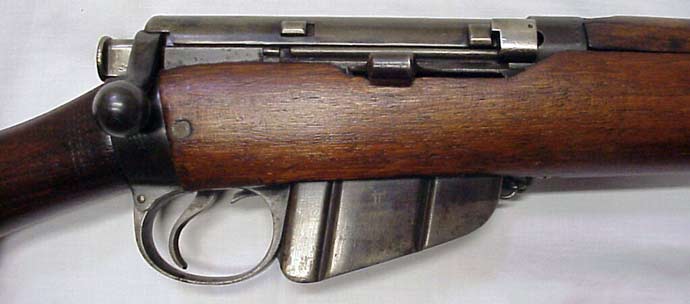
The Lee-Metford rifle (a.k.a. Magazine Lee-Metford, abbreviated MLM) was a breech-loading British army service rifle, combining James Paris Lee's rear-locking bolt system and ten-round magazine with a seven groove rifled barrel designed by William Ellis Metford. It replaced the Martini-Henry rifle in 1888, following nine years of development and trials, but remained in service for only a short time until replaced by the similar Lee-Enfield.
Design
Lee's bolt action mechanism was a great improvement over other designs of the day. The rear-mounted lugs placed the operating handle much closer to the rifleman, over the trigger. This made it much quicker to operate than other, forward-mounted lug designs which forced the rifleman to move his hand forward to operate the bolt; also, the bolt's distance of travel was identical with the length of the cartridge, and its rotation was only 60 degrees compared to the 90 degree rotation of some French and Mauser-style actions. In addition Lee introduced a superior detachable box magazine to replace the common tube and integral box magazines in use with most repeaters, and this magazine offered greater capacity than the competing Mannlicher design.

The Lee-Metford was something of an anachronism, using a black powder-loaded rimmed .303 cartridge; most rifles of that time in a reduced caliber used smokeless powder, and the MLM was intended to make use of a smokeless cartridge, but this was not available when the Lee-Metford was designed. The design went through several variations during its service life, with the principal changes being to the magazine (from eight-round single stack to ten-round staggered), sights, and safety. The Lee-Metford started to be phased out in 1895 in favor of the Lee-Enfield, which was a virtually identical design but adapted for the use of smokeless powder. The Metford pattern of rifling was shallow and subject to rapid wear when ammunition loaded with cordite was used, with barrels becoming unusable after less than 5000 rounds. Changes included a new, deeper rifling pattern (designated Enfield pattern) and sights adjusted for the flatter trajectory enabled by the smokeless propellant.
Replacement
Replacement of the Lee-Metford rifles took several years to achieve, and they were still in service in some units during the Second Boer War in 1899. Troops with the Lee-Metford and even the Lee-Enfield had a disadvantage to the Mauser-equipped Boer troops, when long range accuracy was a concern. Poor sighting-in and quality control at the factory level resulted in British rifles being woefully inaccurate at ranges greater than 400 yards (370 m); upon correction they were essentially equal to the Mauser action in terms of accuracy, and superior in most other attributes. Even so, the British considered a whole new rifle, the Pattern 1913 Enfield, based upon a modified Mauser design, but this was not a success and the eminently adaptable Lee-Enfield served for another half century.
In British service the Lee Metford was also upgraded to the standards of later rifle patterns (e.g. to charger loading and Short Rifle, the SMLE pattern), though the barrel was almost always switched to one with Enfield pattern rifling. The Lee Metford was produced commercially and used by civilian target shooters until the outbreak of World War I, as it was considered to be inherently more accurate than the Enfield pattern of rifling. In this context, barrels could be replaced as frequently as the owner wished, or could afford.





